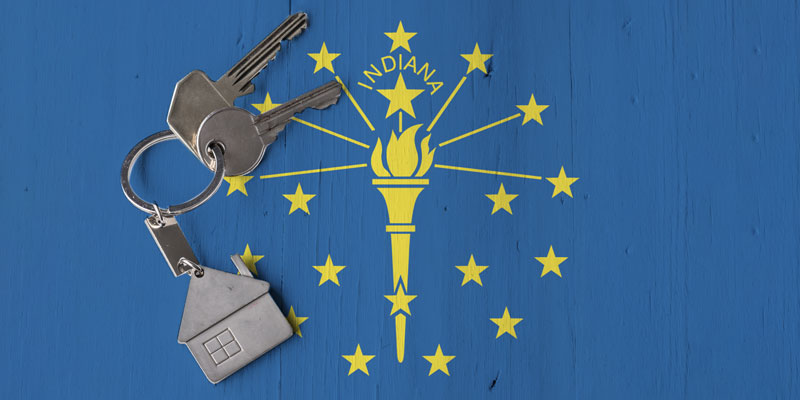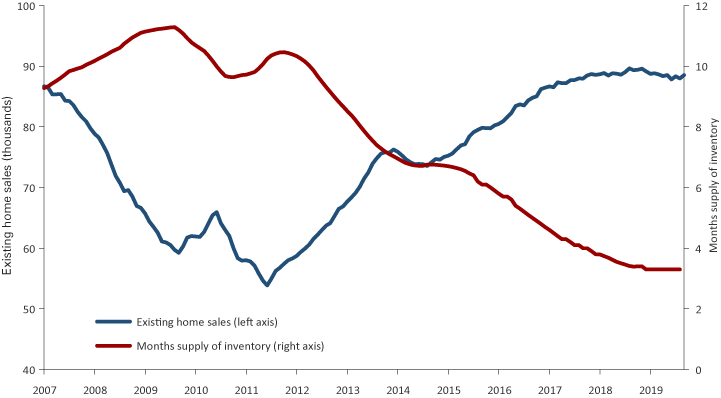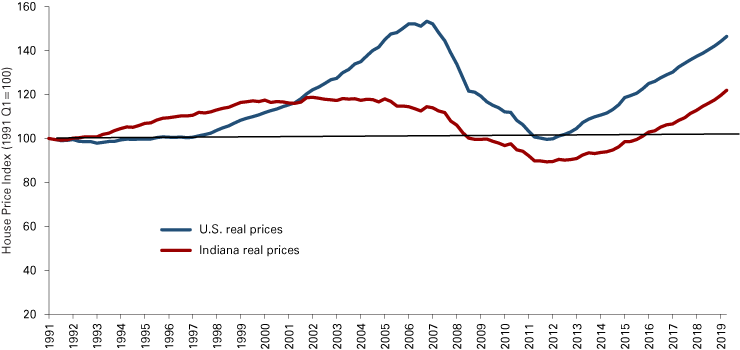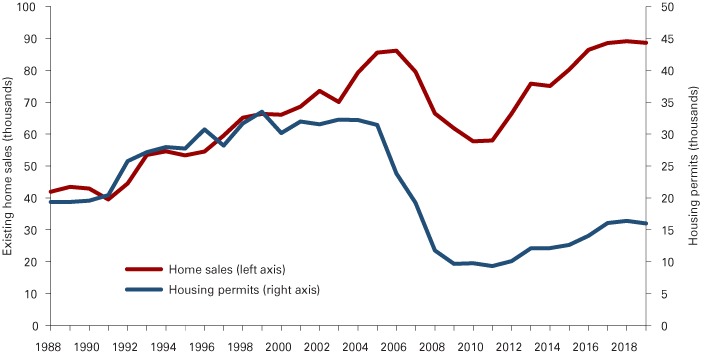
Housing: Positive outlook for 2020

Senior Demographic Analyst, Indiana Business Research Center, Indiana University Kelley School of Business
The Indiana housing market remains locked in a standoff between strong buyer demand and scant supply. After years of growth in existing home sales and dwindling market inventory, however, the state seems to be bumping up against the limits of both measures (see Figure 1).
Figure 1: Indiana existing home sales and months supply of inventory, 12-month moving average

Source: Indiana Association of Realtors
For instance, existing home sales in Indiana remain strong, yet the sales rate through the first three quarters of 2019 is slightly off the record pace set last year. Meanwhile, Indiana’s so-called “months supply of inventory” measure in September 2019 was at an exceptionally low 3.6 months—just a tick lower than the 3.7 mark from the year prior (see Table 1).
Table 1: Housing market overview
| U.S. | Indiana | |
|---|---|---|
| Existing home sales, September year-to-date, year-over-year change | -1.6% | -0.9% |
| House price appreciation, 2018 Q2 to 2019 Q2 | 5.5% | 6.4% |
| Residential building permits, September year-to-date, year-over-year change | 1.3% | 1.7% |
| Foreclosure rate, 2019 Q2 | 0.9% | 1.2% |
| Months supply of existing home inventory, September 2019 | 4.1 | 3.6 |
Source: Indiana Association of Realtors, National Association of Realtors, Federal Housing Finance Administration, U.S. Census Bureau and the Mortgage Bankers Association
All the while, these stubbornly tight market conditions are fueling an unprecedented surge in house price appreciation in the state. The Federal Housing Finance Agency’s House Price Index indicates that Indiana house prices increased 6.4 percent year-over-year in the second quarter of 2019. This strong mark comes on the heels of annual gains of approximately 7 percent in both 2017 and 2018. Prior to these current market dynamics taking hold, the only time in the last 28 years that Indiana had an annual price gain above 6 percent was in the first quarter of 1994.
This sustained period of rapid price growth has pushed Indiana’s “real” house prices (i.e., adjusted for inflation) to new highs in 2019 (see Figure 2 ). The early 2000s had long represented the peak period for house prices in the state. That changed in 2019 as real house prices in Indiana have eclipsed the previous record high set back in 2002. Given the current state of the market, Indiana can expect to see its real house prices continue to climb.
Figure 2 : House Price Index adjusted for inflation, 1991 Q1 to 2019 Q2

Note: The HPI values are adjusted for inflation using the Consumer Price Index for all items less shelter (Series SA0L2).
Source: Federal Housing Finance Agency, House Price Index (expanded data series, seasonally adjusted)
Short supply and rising prices would seem to suggest the need for more new construction. Indiana has seen a slight uptick in housing starts, with the number of new building permits up 1.7 percent year-over-year through the first three quarters of 2019. This increase was driven entirely by growth in multifamily construction, as permits for new single-family homes so far in 2019 is down nearly 3 percent year-over-year.
Even with a modest increase in total units in 2019, residential construction remains relatively low. This point is best demonstrated by comparing new construction to existing home sales. Between 1988 and 2005, there was a fairly consistent ratio of approximately two existing home sales for each single-family building permit in Indiana (see Figure 3). In 2019, however, that ratio will likely be greater than five-to-one. This gap has begun to narrow over the last three years, but we will likely have to see the construction of more low-to-moderate priced homes before there is a significant shift in this trend.
Figure 3: Indiana existing home sales and single-family housing permits

Note: The IBRC estimated the values for 2019 based on data for the first three quarters of the year.
Source: U.S. Census Bureau, Moody’s Economy.com, Indiana Association of Realtors and the Indiana Business Research Center
Outlook
At the national level, the consensus outlook points to a continued uptick in construction and—after what will likely be a decline in 2019—a slight improvement in existing home sales (see Table 2). Meanwhile, prices will continue to rise, although at a slower pace than in the last year, and mortgage rates are expected to remain below the 4 percent mark.
Table 2: National housing outlook, 2019
| 2019 | 2020 | Percent change | |
|---|---|---|---|
| Housing starts (thousands) | 1,257 | 1,291 | 2.7% |
| Existing home sales (thousands) | 5,373 | 5,473 | 1.9% |
| House price appreciation, annual percent change | 4.3% | 3.1% | - |
| 30-year fixed mortgage rate | 3.8% | 3.8% | - |
Note: The values in this table are an average of the projections from each organization’s October 2019 economic forecasts. The value for house price appreciation is drawn from the Mortgage Bankers Association forecast only.
Source: Freddie Mac and Mortgage Bankers Association
Here in Indiana, with the inventory of homes on the market likely to remain exceptionally low in 2020, we expect that total housing starts will continue to increase, and that single-family construction in particular will expand next year after what will likely be a downturn in 2019.
Other consequences of Indiana’s short housing supply will be that the number of existing home sales will have a difficult time improving on the 2019 sales tally, and the rate of house price gains will continue to be higher than the state’s historic norm, but should fall short of the brisk pace set in 2019.
Even with mortgage rates expected to remain very low, Indiana’s strong house price gains threaten to put homeownership out of the reach of more and more Hoosiers. The state will need to see the construction of more lower-to-moderately priced homes to help bring more balance to the housing market.



